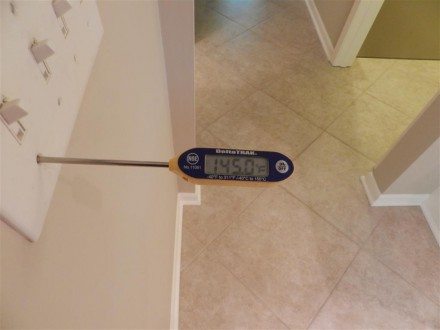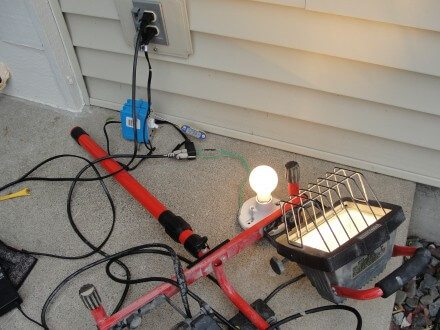Have you ever brushed your hand up against a dimmer switch and noticed that some of them get extremely hot? I’ve done this many times while inspecting houses, and whenever I do, I look in to the reason for the heat. Occasionally I find an overloaded dimmer switch that creates a fire hazard.
To figure out if a dimmer switch is overloaded, you can add up the wattage of the lights that are being controlled, and compare that to the rating on the dimmer switch. The majority of dimmer switches are rated for 600 watts – this rating can be found right on the front of the dimmer switch, underneath the cover plate.
In the photo above, you’ll see the 600 watt rating, as well as 500 and 400 watt ratings. When two of these dimmer switches are installed right next to each other, the little metal tabs will need to be broken off on one side of each dimmer, and the total allowable wattage gets reduced, or ‘derated’. In the photo below, the tabs are removed on one side of each of the dimmers, derating the maximum allowable wattage on each to 500 watts.
When more wattage is needed, special dimmer switches rated for higher wattages can be installed – for instance, Lutron sells a line of dimmer switches that are rated for 1000 watts each, and these dimmer switches don’t take up any more room in an electrical box than a standard 600 watt dimmer switch. While this is a lot of wattage, it’s not all that uncommon. I’ve actually come across several twelve-light chandeliers that take 60-watts bulbs; 720 watts for a single fixture.
So, getting back to the temperature thing – if you put your hand against a cover plate and it feels hot, is this a problem? I started thinking more about this while inspecting a house in Plymouth the other day, after finding eight 65-watt bulbs controlled by a dimmer switch that was installed right next to another dimmer switch – it was the one pictured above. In other words, the dimmer was controlling 520 watts, but was only rated 500 watts. I noticed that the cover plate was very hot, so I pulled out one of the cover plate screws and stuck my thermometer in to the hole – it was 145 degrees.
Out of curiosity, I set up a little experiment to get a better idea of how overloading a dimmer switch would affect it’s temperature. It should go without saying, but I’ll say it anyway – Don’t try this at home. You could set your house on fire, get electrocuted, or your wife might wonder why you’re doing some dumb experiment instead of helping with the yard work. Don’t ask how I know.
I installed a 600 watt dimmer switch in a single gang, 18 cubic inch box, and ran some lights off it. Of course, there are plenty of variables that aren’t being factored in to this little experiment, such as the box not being installed inside a wall, no cover plate installed, etc… but this was good enough for me to make a few comparisons, which is really all I was after. I turned the dimmer switch on to full brightness, and measured the temperatures by sticking my thermometer in to a cover plate screw hole; this seemed like a good way to get consistent temperatures.
With a 600 watt dimmer running a full 600 watts of lights, the temperature got up to 135 degrees. At 750 watts, the dimmer switch got up to 158 degrees. Next, I tested a 1000 watt dimmer with a full 1000 watts. This was the part that made me smile – the temperature went up to exactly 135 degrees.
Conclusion: A properly installed, fully loaded dimmer switch will get quite hot to the touch. This isn’t necessarily a problem, but when dimmer switches get hot, it’s worth checking the rating of the dimmer switch and the wattage going through the dimmer to help make sure the dimmer switch isn’t overloaded.
By the way, this post is focused on ‘new’ dimmer switches, which get hot with lights at their brightest setting. Older dimmer switches did the opposite – they would get hottest with the lights at their dimmest setting. You can read all about how the two different types work at HowStuffWorks – Dimmer Switches.
Reuben Saltzman, Structure Tech Home Inspections – Email – Minnesota Home Inspections









Jim Allhiser
May 22, 2012, 5:25 am
Great post Reuben! How much would you love to be a Myth Buster?
Rembrandt
May 22, 2012, 9:51 am
Thanks for the information. Very useful.
Reuben Saltzman
May 25, 2012, 3:48 am
Jim – it’s my dream. I think about them any time I’m doing any kind of experiment, and I insist that my wife call me either Adam or Jamie. I also wear my Mythbusters t-shirt.
Dimmer Switch On Ceiling Fan = Fire Hazard | Structure Tech Home Inspections
June 23, 2012, 7:17 am
[…] but like any other DIY project, I often find them installed improperly. I recently wrote about overloaded dimmer switches, but the most common problem I find is a dimmer switch connected to a ceiling […]
Brian
November 3, 2012, 12:12 pm
This post answered my question exactly about the new dimmer switch I installed. I really appreciate the thorough, clear answer.
David
March 2, 2013, 11:28 am
Very clear and useful information. I just replaced a dimmer that went bad. First thing I did (after I turned it off) was check the internet and found this. I have 10 65 watt lights = 650 = trip back to store for some lower watt bulbs!
David
April 18, 2013, 9:10 pm
If you read through the warnings on most paperwork for the dimmer, the more lights you hook up to it, the lower the wattage is. The one I purchased, cheapest HD Leviiton model, it says that with 2 lights , the max wattage is 500, with more than 2 lights, the rating is 400Watts. I.e, go for the 1000W.
Reuben Saltzman
April 19, 2013, 3:39 am
Very interesting David, I’ve never noticed that before. Thanks for the info.
Richard Freda
July 31, 2013, 9:12 am
Reuben,
Great info. As a handyman, I have a regular customer who had a lighting company that sold him a chandelier install it for him. It is rated for 60 watt type B bulbs. There are 16 of them. I figured total wattage for the fixture to be 960. The electrician for the company, special ordered the dimmer rated for 1000 max. My customer was concerned with the amount of heat on the dimmer. I told him UL lists temperature ratings for dimmers to be no more than 140 degrees, so it is probably close to that. I don’t have that handy thermometer to test it but on a relative scale it took 6-7 seconds or so before it was uncomfortable to the touch. Would reducing the wattage for each bulb, thereby reducing the total wattage for the fixture reduce the heat dissipation (which I believe dissipation rate is 1 watt per 100 used)?
Jen
October 25, 2013, 12:17 pm
Very helpful and makes me question something. I have 8 – 8 watt (45 equivelant) LEDs hooked up to a dimmer with all tabs off (I did check and it’s an LED Dimmer). The switch doesnt get hot… Should I be concerned? The switch for the ceiling fan (no lights) also has all tabs broken off.
Sebastien
November 20, 2013, 12:20 am
David is wrong. It is not the number of lights that de-rates the wattage of the dimmer switch, it is the number of dimmer switches within a single wall box. If two dimmers are side-by-side, the usual rule is that both dimmers are derated by 100 W (e.g. a 600W dimmer would be limited to 500 W). If more than 2 dimmers are together, then they each lose 200 W.
This is because the heat is transmitted from the dimmers to the metal box, so the more dimmers within a single box, the more heat is generated within that box.
Tim
December 18, 2013, 4:23 pm
Sebastein is right and a little wrong the de-rating of the dimmers comes from breaking off the tabs on the side of the dimmers. If you have two dimmers, then the sides of the dimmers that touch each other each have the tabs removed, de-raring by about 100watts. if you have 3 or more the dimmers in the middle have both sides of the dimmers removed de-rating those dimmers (in the middle) by about 200watts. Hope this makes since.